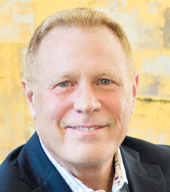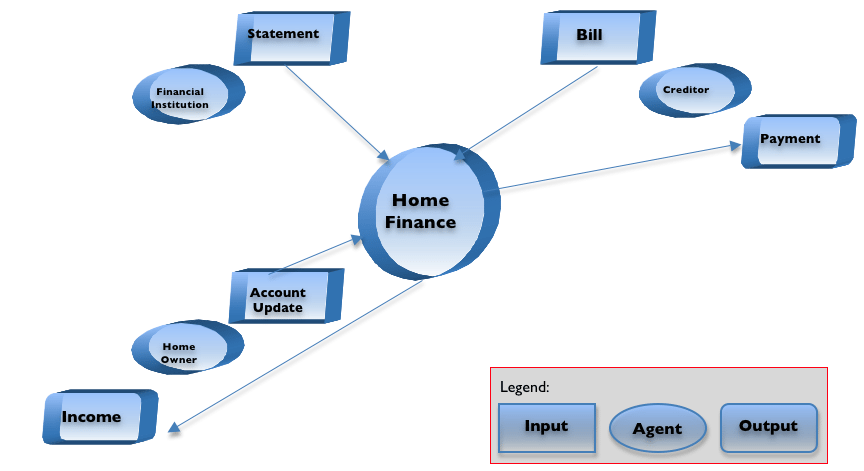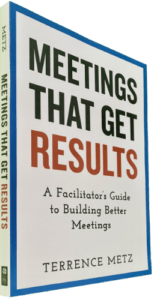Most of us have heard that a picture tells a thousand words. Consensually built pictures, especially those covering complex topics and interactions, can be used to help solve and resolve a thousand arguments.
We are reminded by the IIBA (International Institute of Business Analysis) Quick Tip Bulletin #58 about the value of one type of picture of the business, called a Context Diagram.
A Context Diagram, also known as a Scoping Picture or Picture of the Business (area) may look complicated and un-informing to the uninformed, but a picture of the business quickly enables a session leader to tighten the reign on scope creep issues that plague many meetings and workshops.
The Context Diagram on the right illustrates “who” the business interacts (here, an organization or business called “Home Finance”) with, “what” the business receives from them, and “what” the business gives to them. Many refer to the “whats” as inputs and outputs. Inputs and outputs are used in requirements gathering to narrow the scope of discovery and discussion. The picture helps both the participants and the facilitator focus on the deliverable.
How to Build a Context Diagram
Consider using the simple agenda shown below. It captures the answers to three simple questions to complete the modeling:
- WHO do we work with to support our purpose (e.g., Actors or Agents)?
- WHAT do we get from them (inputs)?
- WHAT do we give them (outputs)?
Consequently, modify this “plain vanilla” agenda for a Context Diagram as shown or as you see fit. Use the MGRUSH 7-step introductory sequence and 4-step review and wrap for the workshop bookends. Have an ample supply of Post-It® Notes available, in at least three different colors, sizes, or shapes to distinguish the WHO from the inputs and outputs. Once complete, and consensually validated, you can proceed further with follow-up meetings or workshops to further define and illustrate WHO the business uses to support its purpose, and what activities (Activity Flow or Functional Decomposition workshop, leading to use cases such as SIPOC) and information (Logical Modeling or Entity Relationship Diagram) are also required to support their business purpose.
The following shows the simple agenda that typically takes two to four hours to complete. Also, refer to your MG Rush Professional Facilitative Leadership manual for more details.
- INTRODUCTION
- PURPOSE OF THE BUSINESS AREA
- WHO INTERACTS (Actors)
- WHAT COMES IN (Inputs)
- WHAT GOES OUT (Outputs)
- MODEL AND VALIDATION (Walk-thru)
- THE SCOPE DEFINED (Narrative)
- REVIEW AND WRAP
______
Don’t ruin your career by hosting bad meetings. Register for a workshop or forward this to someone who should. MGRUSH facilitation workshops focus on meeting design and practice. Each participant practices tools, methods, and activities every day during the week. Therefore, while some call this immersion, we call it the road to building high-value facilitation skills.
Our workshops also provide a superb way to earn up to 40 SEUs from the Scrum Alliance, 40 CDUs from IIBA, 40 Continuous Learning Points (CLPs) based on Federal Acquisition Certification Continuous Professional Learning Requirements using Training and Education activities, 40 Professional Development Units (PDUs) from SAVE International®, as well as 4.0 CEUs for other professions. (See workshop descriptions for details.)
Want a free 10-minute break timer? Sign up for our once-monthly newsletter HERE and receive a timer along with four other of our favorite facilitation tools, free.
Related articles
- Benefits and Best Practices Using Structured Facilitative Workshops (mgrush.com/blog)
- What is the Difference Between Structured Facilitation and Kum Ba Yah Facilitation? (mgrush.com/blog)
- Guidelines for Selecting Appropriate Structured Facilitation Tools (mgrush.com/blog)
- Phase One Results from a Facilitated Business Process Improvement Project (mgrush.com/blog)
- Why We Need Trained, Professional Facilitators Who Can Guard Against Bias (mgrush.com/blog)

Terrence Metz, president of MG RUSH Facilitation Training, was just 22-years-old and working as a Sales Engineer at Honeywell when he recognized a widespread problem—most meetings were ineffective and poorly led, wasting both time and company resources. However, he also observed meetings that worked. What set them apart? A well-prepared leader who structured the session to ensure participants contributed meaningfully and achieved clear outcomes.
Throughout his career, Metz, who earned an MBA from Kellogg (Northwestern University) experienced and also trained in various facilitation techniques. In 2004, he purchased MG RUSH where he shifted his focus toward improving established meeting designs and building a curriculum that would teach others how to lead, facilitate, and structure meetings that drive results. His expertise in training world-class facilitators led to the 2020 publication of Meetings That Get Results: A Guide to Building Better Meetings, a comprehensive resource on effectively building consensus.
Grounded in the principle that “nobody is smarter than everybody,” the book details the why, what, and how of building consensus when making decisions, planning, and solving problems. Along with a Participant’s Guide and supplemental workshops, it supports learning from foundational awareness to professional certification.
Metz’s first book, Change or Die: A Business Process Improvement Manual, tackled the challenges of process optimization. His upcoming book, Catalyst: Facilitating Innovation, focuses on meetings and workshops that don’t simply end when time runs out but conclude with actionable next steps and clear assignments—ensuring progress beyond discussions and ideas.





Reblogged this on Gr8fullsoul.
Well I am a project manager and have been going through the guide to Scrum Body of Knowledge by Scrumstudy which provide a complete guide for the scrum project. I highly recommend this books to all those who are planning to implement scrum in your organization. You can go directly to http://www.SCRUMstudy.com for first chapter is available there.